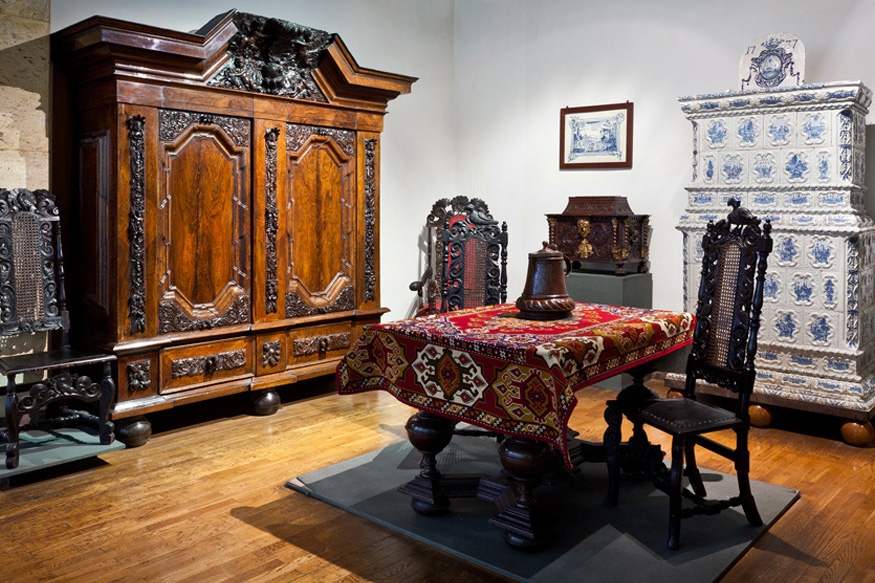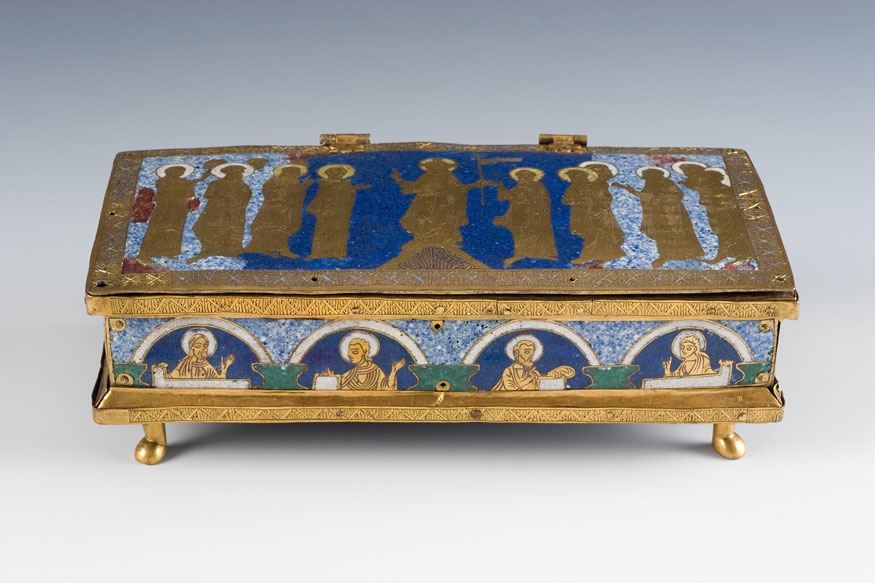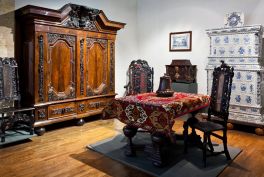MNK The Main Building
al. 3 Maja 1 second floor- Monday: closed
- Tuesday - Sunday: 10.00-18.00
Information and reservations on weekdays 9 a.m.- 4 p.m.
The Director of the National Museum in Krakow
Deputy Director for Programme Activity
Deputy Director for Strategy and Communications
Deputy director for the Management
Chief Accountant
Chief Cataloguer of the National Museum in Krakow
Chief Conservator
The Gallery of Decorative Art at the National Museum in Krakow is the largest permanent exhibition of this type in Poland. The displayed objects are arranged in a chronological order from the Early Middle Ages to the Art Nouveau period. The exhibition, with its stylishly arranged interiors and its collection of gold, fabrics, clothing, furniture, ceramics and glassware, complete with a unique collection of musical instruments and judaica, features nearly 4,000 exhibits presented in nine exhibition rooms and two annexes.
The Museum boasts some historic fabrics and clothing dating back to the period from the 14th to the early 20th century. The oldest artefact in the collection is a 14th-century stole from the Benedictine Abbey in Tyniec. Another impressive item is the set of chasubles from the 15th to 18th centuries, featuring some particularly valuable 15th-century examples with embroidered orphreys or made from imported Italian fabrics. The Gallery also houses valuable silk kontusz sashes from the 17th and 18th centuries, which include a particularly noteworthy Persian cummerbund from the second half of the 17th century, decorated with depictions of falconers. The collection of dresses dating from the early 19th to the early 20th century offers a complete fashion overview of the entire century, complemented by accessories such as shawls, underwear, fans, gloves and jewellery.
Silver and enamel exhibits featured in the gold display form a diverse collection. Some of the most noteworthy and oldest objects include the so-called Włocławek Goblet – a unique artefact on a European scale dating back to the first half of the 10th century – and the Kruszwica Reliquary from the 12th century. The Gallery also presents the most representative collection of Polish 16th and 17th century spoons inscribed with sentences in Polish. The collection also includes silver and partially gilded vessels, for both secular and religious use produced in manufacturing centres in Poland – Krakow, Lviv, Gdańsk and Toruń – and leading European centres in Wrocław, Augsburg, Nuremburg and Hamburg. The display is complemented by a precious collection of Polish dress buttons and metal bands, including silver buttons from the 17th and 18th centuries. Amongst the most noteworthy 19th-century items are the silver objects from Krakow and Warsaw workshops.
A special place in the Gallery is held by stained-glass window elements from the Dominican Church in Krakow, the only collection of medieval stained glass of this size preserved in Polish museums. Another valuable group is the set of Baroque glassware from Polish manufacturing centres such as Huta Kryształowa, Naliboki and Urzecze. The Gallery also presents one of the best Polish collections of Central European – mostly Czech – Biedermeier glassware and the collection of glassware from the second half of the 19th century, representative of the Historicism style in Italy and Austria.
Another interesting group is the ceramics collection – unquestionably one of the most impressive and important of its kind in Poland. It includes Romanesque floor slabs, Gothic and Baroque tiles, Italian majolicas from the 16th century and Polish faiences from the 18th century. The most valuable artefacts come from the royal factory in Belweder and Karol Wolff's workshops in Bielino, Warsaw. Particularly noteworthy are the tureen, platter and plate from the Sultan's Service dating back to 1777 and the 'Tsun' vase from the factory of Karol Wolff from the years 1780-1795. The Museum's collections also include numerous examples of porcelain from the most renowned European manufacturing centres – Meissen, Vienna, Berlin and Sèvres. Valuable ceramic collections also originate from Polish factories in Korzec, Baranówka, Tomaszów Lubelski, Ćmielów and Nieborów.
The collection of exhibits made of various kinds of metal includes several medieval bronze vessels and a large set of Gothic – and later – bells and mortars. Particularly noteworthy is the large chemist's mortar, cast by a Gdańsk bell-founder Gerard Benning in 1623. The collection also features numerous vessels and tin objects dating back to the 17th – 20th centuries and a large number of blacksmith and locksmith artefacts such as strongboxes, locks, and keys.
Among the European furniture displayed in the Gallery, particularly noteworthy are the Spanish vargueno (cabinet) from the turn of the 15th and 16th centuries, cabinets made in Genoa, and several Rococo furniture items from France. The core of the collection consists, however, of 18th-century pieces from Gdańsk and Kolbuszowa, as well as Empire, Biedermeier and Art Nouveau items. Note also the large set of small furniture pieces consisting of jewellery chests, guild chests, trunks, boxes, and caskets decorated using intarsia and inlay techniques.
The Gallery also houses a valuable collection of 17th and 18th-century tile clocks, including two from the workshop of Wolfgang Prenner in Krakow. Another unique artefact is the ball clock from the workshop of Dawid Schröter in Elbląg. The collection also comprises table, cabinet, plate and mantle clocks. The clocks made by Jan Gotfried Krosz in the second half of the 18th century are of particular value and include a clock with a figure of Chronos and a rare example of a travel clock. The National Museum in Krakow boasts the best Polish collection of Empire clocks (mainly mantle clocks), the most valuable of which are presented in the Gallery. The display is complemented by 19th-century clocks in Biedermeier style.
Visitors to the room presenting artefacts from the turn of the 18th and 19th centuries may begin their tour with a cabinet containing objects related to important Polish figures such as Tadeusz Kościuszko, Prince Józef Poniatowski and memorabilia associated with significant historical events, e.g. the adoption of the 3 May Constitution. Another room features Adam Mickiewicz's personal items such as his wallet, calling card, pencil, goose quill, snuffboxes and pipes.
The collection of judaica, purchased by the National Museum in Krakow in the years 1935-1939, constitutes the most impressive set of Jewish culture artefacts in Poland and contains objects of established provenance. A separate annexe of the Gallery contains objects associated with synagogue and home ceremonies, including Hanukkah lamps, yads and spice towers.
Gallery of Decorative Art, decorative art, handicraft, antiques, furniture, glassware, ceramics, fabrics, judaica



